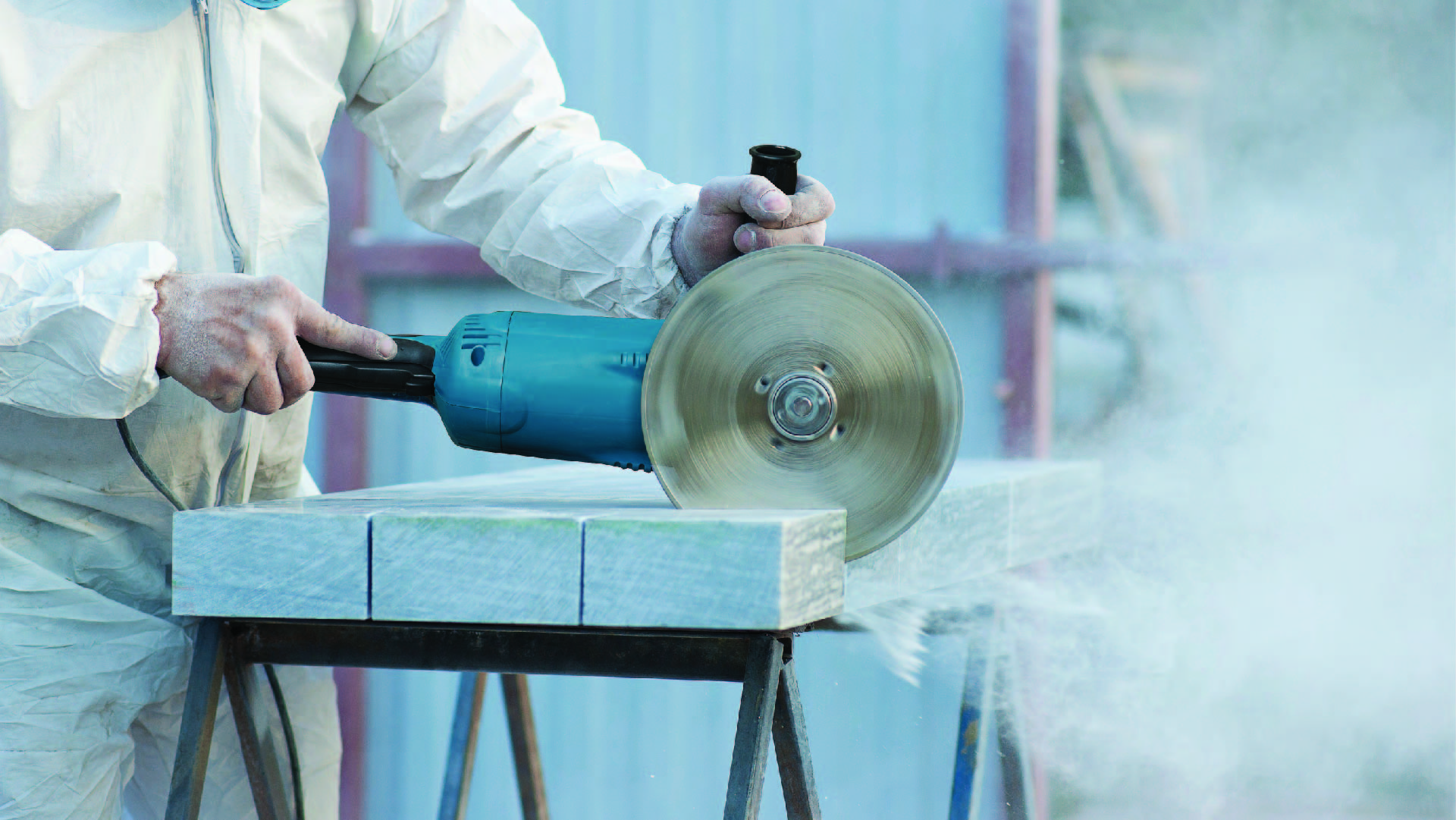This article was co-authored by Hattie Wilson.
In recent years, Australia has seen a significant increase in the number of cases of silicosis and other crystalline silica (silica) related diseases in the workplace. Silica is a naturally occurring mineral which is used in many products such as asphalt, cement, concrete, grout, bricks, and tiles. Engineered stone which is commonly used for kitchen benchtops contains markedly high levels of silica (up to 90%). Silicosis and silica related diseases occur when silica dust particles are inhaled (for example, due to sawing, cutting or drilling products containing silica) and become lodged in the lungs.
Given the recent increase in cases and the severe negative health impacts of silica related diseases, the regulation of silica has been an area of continued focus across Australia for some time. Engineered stone in particular has been an area of focus, with consideration being given to banning this product altogether. Below is a status update on the regulation of silica across the country.
Potential ban of engineered stone
On 27 October 2023, Safe Work Australia released to the public the much awaited ‘Decision Regulation Impact Statement: Prohibition on the use of engineered stone’ (Decision RIS), recommending that the ministers responsible for WHS matters around Australia ‘prohibit the use of all engineered stone, and implement a licensing scheme for certain work with engineered stone previously installed’. The Decision RIS was provided to Commonwealth, state and territory WHS Ministers on 16 August 2023 for their consideration. The WHS Ministers are yet to decide whether to implement the recommendation.
The Decision RIS also considered other options involving a prohibition of the use of engineered stone containing 40% or more silica. However, the Decision RIS considered that a lower silica content in engineered stone would not result in improved compliance with silica regulations, and that there is a lack of evidence showing that products containing lesser amounts of silica pose less risks to health and safety.
There have been other signs indicating that the ban will progress – for example, at its 49th national conference in Brisbane in August 2023, the Australian Labor Party (ALP) agreed to take “all necessary measures” to eliminate silicosis “including a ban on the manufacture, use and import of harmful engineered stone products”. State leaders have indicated their support (or likely support) for the ban including Australian Capital Territory ACT Industrial Relations and Workplace Safety Minister Mick Gentleman and New South Wales Premier Chris Minns.
Unions around Australia also actively support a ban on the use of engineered stone. For example, the construction union, CFMEU, has indicated that it will itself ‘ban’ the use of engineered stone by July 2024 if the government fails to do so (see here), by educating union members and elected health and safety representatives on the dangers of working with engineered stone and their rights to refuse unsafe work. On 24 October 2023, the Australian Council of Trade Unions agreed to a resolution urging all affiliates to “take all necessary steps to take action to support bans at the workplace level’.
Regulation of silica under the model WHS Laws
All jurisdictions in Australia (except Victoria) have implemented harmonised work health and safety laws known as the model Work Health and Safety Laws (Model WHS Laws). The Model WHS Laws are published by Safe Work Australia, and have legal effect in individual jurisdictions that have adopted the recommended provisions.
The Model WHS Laws contain various obligations relevant to the management of silica risks. Some of the key obligations include:
- An express prohibition on the uncontrolled processing of engineered stone (i.e. without the use of respiratory protective equipment, and either a water delivery system, on-tool extraction system or local exhaust ventilation system, to suppress the generation of dust).
- Obligations to ensure that the workplace exposure standard for silica dust is not exceeded. The workplace exposure standard for respirable silica is 0.05 milligrams per cubic metre (mg/m3) for an eight hour time weighted average (see here for details).
- Obligations to carry out air monitoring where necessary to determine whether the exposure standard has been exceeded or there is a risk to health.
- Obligations to ensure that health monitoring is provided to workers if there is significant risk to a worker’s health because of exposure to silica (see here for guidance).
- General risk management obligations to manage safety risks associated with silica dust exposure (e.g. the primary duty of care).
Safety regulators around Australia are actively enforcing these requirements, and there have been numerous prosecutions brought against organisations for failing to adequately protect workers from silica dust risks.
Safe Work Australia has also developed a model code of practice, Managing the risks of respirable crystalline silica from engineered stone in the workplace, which again is up to individual jurisdictions to adopt. The Code recommends the use of a silica dust control plan to manage silica dust control risks, among other matters.
Silica regulation across Australia
The following table provides a summary of the status of silica regulation in each jurisdiction. Most jurisdictions have adopted the silica requirements in the Model WHS Laws outlined above, including some form of prohibition on the uncontrolled processing of engineered stone. Some jurisdictions have also adopted additional requirements for silica (e.g. training requirements).
| Jurisdiction |
Legislation |
Code of practice |
Summary of silica provisions |
| Commonwealth |
Work Health and Safety Act 2011 (Cth)
Work Health and Safety Regulations 2011 (Cth) |
Work Health and Safety (Managing the Risks of Respirable Crystalline Silica from Engineered Stone in the Workplace) Code of Practice 2022 |
The Commonwealth has generally adopted the Model WHS Laws, including an express prohibition on the uncontrolled processing of engineered stone.
|
| New South Wales |
Work Health and Safety Act 2011 (NSW) (NSW WHS Act)
Work Health and Safety Regulation 2017 (NSW) |
Managing the risks of respirable crystalline silica from engineered stone in the workplace |
New South Wales has generally adopted the Model WHS Laws, including an express prohibition on the uncontrolled processing of engineered stone.
On 12 October 2023, New South Wales passed the Work Health and Safety Amendment Act 2023 amending the NSW WHS Act, to enable SafeWork NSW to establish a silica worker register and require organisations to provide SafeWork NSW with information for inclusion in the register as required under the regulations (which are yet to be published). The register will not be publicly available, but can be accessed by specified agencies for certain purposes. |
| Victoria |
Occupational Health and Safety Act 2004 (Vic)
Occupational Health and Safety Regulations 2017 (Vic) (OHS Regulations) |
Managing exposure to crystalline silica: engineered stone
|
Victoria has not adopted the Model WHS Laws, but it has similar provisions in place under its OHS Regulations, including an express prohibition on the uncontrolled processing of engineered stone.
Victoria has also introduced a range of specific duties for silica and engineered stone in Part 4.5 of the OHS Regulations. These include requiring employers to conduct a risk assessment prior to undertaking a silica process to identify whether work is high risk silica work and prepare a silica hazard control statement for high risk silica work, imposing licensing requirements for engineered stone, as well as imposing various training requirements on employers.
|
| Queensland |
Work Health and Safety Act 2011 (Qld)
Work Health and Safety Regulation 2011 (Qld) |
Code of practice on preventing exposure to silica dust in the stone benchtop industry
Managing respirable crystalline silica (RCS) dust exposure in construction and manufacturing of construction elements |
Queensland has generally adopted the Model WHS Laws, including an express prohibition on the uncontrolled processing of engineered stone.
|
| Western Australia |
Work Health and Safety Act 2020 (WA)
Work Health and Safety (General) Regulations 2022 (WA) |
Managing the risks of respirable crystalline silica from engineered stone in the workplace |
Western Australia has generally adopted the Model WHS Laws, including an express prohibition on the uncontrolled processing of engineered stone.
|
| South Australia |
Work Health and Safety Act 2012 (SA)
Work Health and Safety Regulation 2012 (SA) |
South Australia has not yet approved a code of practice in relation to silica, but the SafeWork SA website provides a link to the national code |
South Australia has generally adopted the Model WHS Laws, including an express prohibition on the uncontrolled processing of engineered stone.
A private members bill (see here) has also been introduced to parliament which proposes to prohibit work that exposes a person to silica dust. The Bill was referred to the Parliamentary Committee on Occupational Safety, Rehabilitation and Compensation for review and recommendations. |
| Australian Capital Territory |
Work Health and Safety Act 2011 (ACT)
Work Health and Safety Regulation 2011 (ACT) |
Managing the Risks of Airborne Crystalline Silica (Silica Dust) in the Workplace |
The Australian Capital Territory has generally adopted the Model WHS Laws, including an express prohibition on the uncontrolled processing of engineered stone. It also requires organisations to provide specific training to workers who carry out high risk crystalline silica work. |
| Tasmania |
Work Health and Safety Act 2012 (SA)
Work Health and Safety Regulations 2022 (SA) |
Managing the risks of respirable crystalline silica from engineered stone in the workplace |
Tasmania has generally adopted the Model WHS Laws. However, at this stage it has not adopted the express prohibition on the uncontrolled processing of engineered stone. |
| Northern Territory |
Work Health and Safety (National Uniform Legislation) Act 2011 (NT)
Work Health and Safety (National Uniform Legislation) Regulations 2011 (NT) |
The Northern Territory has not yet approved a code of practice in respect of silica, but has released a draft code Managing psychosocial hazards at work
|
The Northern Territory has generally adopted the Model WHS Laws. However, at this stage it has not adopted the express prohibition on the uncontrolled processing of engineered stone.
|
| |
|
|
|






